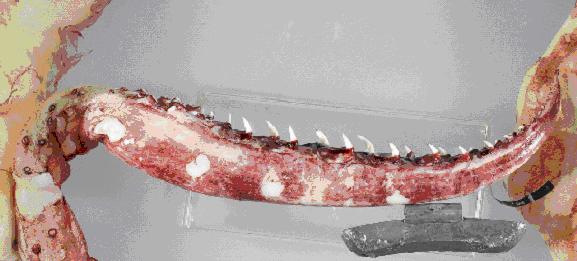
Posted on 02/22/2007 12:51:48 AM PST by Stoat
New Zealand fishermen in the Ross Sea have caught what's thought to be the largest squid ever found.
Its estimated weight is about 450 kilograms.
The species is known as the colossal squid, shorter but much heavier than the better known giant squid.
It was hauled to the surface while munching on one of its favourite foods, a Patagonian toothfish which the fishermen had hooked on a longline.
Dr Steve O'Shea, from the Auckland University of Technology, says the previous largest find weighed 300 kilograms.
He says if calamari were made from the squid the rings would be the size of tractor tyres.
The squid was caught three weeks ago, but the find was only announced today.
Geoff Dolan, an observer with New Zealand's Ministry of Fisheries, was aboard the vessel San Aspiring, owned by the Sanford seafood company, when the squid was hauled aboard.
"There was quite a lot of excitement onboard ... the decision was taken that the chances of survival were not good, and in the interests of science it should be taken on board," Dolan said.
Sanford's deepwater division manager Greg Johansson said the squid was barely alive when it was pulled aboard.
"It was deemed that is was more valuable to science," Johansson said.
The squid was taken below deck and stored in a 1200 litre capacity bin, before it was frozen.
It has since been transferred to one of the company's coolrooms in Timaru, on New Zealand's South Island.
It will ultimately end up at the Museum of New Zealand Te Papa Tongarewa in Wellington, where it will be preserved for scientific study.
Colossal squid were first described in 1925 after two tentacles were found in the stomach of a sperm whale.
The creatures live in an area from Antarctica to the southern extremities of South America, South Africa and New Zealand, a statement from the New Zealand government said.
It said few colossal squid have been sighted, with one was caught in the net of a Russian trawler in the Ross Sea in 1981, another found near the surface in 2003, and another near South Georgia Island in the Southern Atlantic ocean on a toothfish longline last year.
New Zealand Fisheries Minister Jim Anderton said the squid, weighing an estimated 990 pounds, took two hours to land in Antarctic waters.
Thanks for the post. Thats some Calamari.
Wow!
Calimari! For 500 close friends and relatives! :-)

Crypto ping
Big Squid

Colossal Squid Information from Answers.com

Colossal Squid caught by Soviet trawler in 1981.
Copyright: Alexander Remeslo (photographer)
| iColossal Squid | ||||||||||||||||
|---|---|---|---|---|---|---|---|---|---|---|---|---|---|---|---|---|
![This specimen was caught at 2500 feet (760 m) in the Antarctic off Droning Maud Land by the Soviet trawler Evrica in 1981. Photograph by Alexander Remeslo.[1]](http://content.answers.com/main/content/wp/en/thumb/b/b1/200px-Mesonychoteuthis_hamiltoni.jpg) This specimen was caught at 2500 feet (760 m) in the Antarctic off Droning Maud Land by the Soviet trawler Evrica in 1981. Photograph by Alexander Remeslo.[1]
|
||||||||||||||||
| Scientific classification | ||||||||||||||||
|
||||||||||||||||
| Mesonychoteuthis hamiltoni Robson, 1925 |
The Colossal Squid (Mesonychoteuthis hamiltoni), sometimes called the Antarctic or Giant Cranch Squid, is believed to be the largest squid species, and the only member of the genus Mesonychoteuthis. Current estimates put its maximum size at 14 meters (46 feet), based on analysis of smaller and immature specimens, making it the largest known invertebrate.
Unlike the various giant squid species whose tentacles are equipped with suckers lined with small teeth, the tentacles of the Colossal Squid are tipped with a fierce mixture of suckers and swiveling hooks. Its body is wider and stouter, and therefore heavier, than that of the giant squid. Colossal Squids are believed to have a longer mantle than giant squids, although their tentacles are shorter.
The beak of Mesonychoteuthis hamiltoni is the largest known of any squid, exceeding that of Architeuthis in size and robustness. The Colossal Squid is also believed to have the largest eyes in the animal kingdom (even larger than those of giant squid).
The squid's known range extends thousands of miles northward from Antarctica to southern South America, southern South Africa, and the southern tip of New Zealand, making it primarily an inhabitant of the entire circumantarctic Southern Ocean.
While little is known about the life of this creature, it is believed to hunt prey such as chaetognatha and squid in the deep ocean using bioluminescence. Based on capture depths of a few specimens, as well as beaks found in sperm whale stomachs, the adult squid ranges at least to a depth of 2200 m, while juveniles can go as deep as 1000 m.
The squid's method of reproduction has not been observed, although some data on their reproduction can be inferred from anatomy. Since males lack an organ called a hectocotylus (a tentacle used in other cephalopods to transfer a spermatophore to the female), they probably use a penis instead, which would be used to directly implant sperm into females.
Many Sperm whales carry scars on their backs believed to be caused by the hooks of Colossal Squid. Colossal Squid are a major prey item for Antarctic sperm whales feeding in the Southern Ocean; 14% of the squid beaks found in the stomachs of these sperm whales are those of the Colossal Squid, which indicates that Colossal Squid make up 77% of the biomass consumed by these whales.[2] Many other animals also feed on this squid, including the beaked whales (such as the bottlenose whales), Pilot Whale, Southern Elephant Seal, Patagonian toothfish, Pacific sleeper shark, and albatross (e.g., the Wandering and Sooty albatrosses). However, beaks from mature adults have only been recovered from those animals large enough to take such prey (i.e., the sperm whale and Pacific sleeper shark), while the remaining predators are limited to eating juveniles or young adults.
This species was first discovered in 1925, in the form of two tentacles found in the stomach of a sperm whale. In 1981, a Russian trawler in the Ross Sea, off the coast of Antarctica, caught a large squid with a total length of 13 feet / 4 m (see image at top), which was later identified as an immature female of Mesonychoteuthis hamiltoni. In 2003, a complete specimen was found near the surface with a total length of 6 m (20 feet) and a mantle length of 2.5 m (8 feet). On June 25, 2005, a specimen was captured at a depth of 1625 m while taking a toothfish from a longline off South Georgia Island. Although the mantle was not brought aboard, the mantle length was estimated at over 2.5 m (8 feet), and the tentacles measured 230cm. The animal is thought to have weighed between 150 and 200 kg.[3]

I'd need a larger fridge for this... stake, casserole, steamed, fried...
Varieties of menus on my mind right now...
what's the first bid? Haven't tried giant squid before... has anybody?
|
You're quite welcome and I'm delighted that you find it interesting and worthwhile :-)
Thats some Calamari.
Yes, far more than this stoat would care to eat :-)
good one!
Nasty! These things were the source of all the old sailors' stories about the mythical "Kraken."
Thanks for the facts and pics! That is one nasty, huge monster.

Creepy. It looks like a body!
haha! Maybe he got some o' that "juice" from Balco Bonds...
Nightmare stuff, hooked suckers. This is one nasty predator. Happy it never developed feet and air breathing lungs.
(I'm for the whales. Someone has to cull the squid...)

I had no idea that squidology was still using tire-balance lead weights to provide a sizing scale.... I thought they'd upgraded to iPod-relative measures. ;-)
Holy Cthulu!
Disclaimer: Opinions posted on Free Republic are those of the individual posters and do not necessarily represent the opinion of Free Republic or its management. All materials posted herein are protected by copyright law and the exemption for fair use of copyrighted works.